


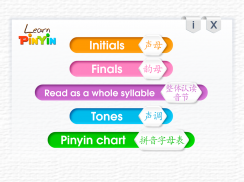
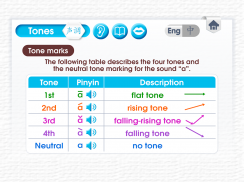
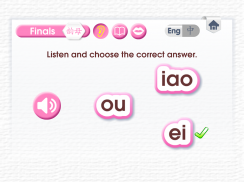
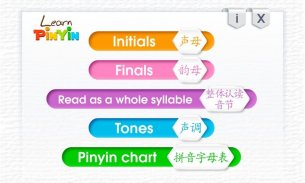
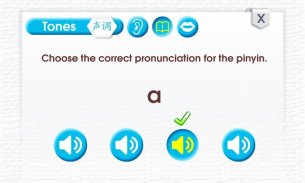
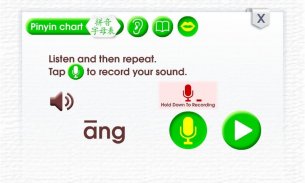
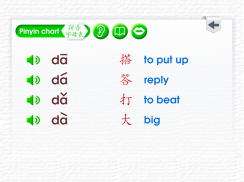

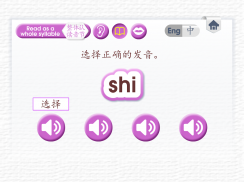
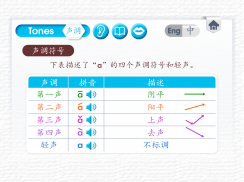
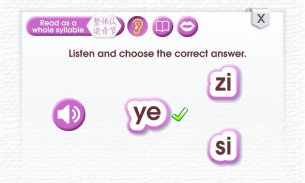
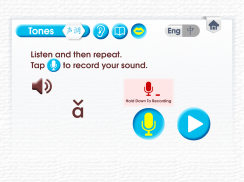
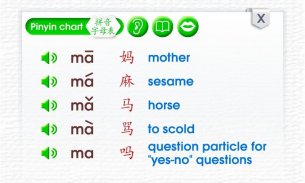
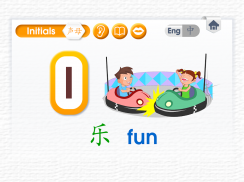
Learn Pinyin

Descrição de Learn Pinyin
Pinyin, short for Hanyu Pinyin, means "phonetic notation" or "phonetic symbols". Pin means "spelling" and Yin means "sound(s)". Pinyin is a system of romanization (phonemic notation and transcription to Roman script) for Standard Mandarin. There are 21 initials/consonants and 35 finals/vowels in Mandarin.
Pronunciation of Mandarin comes with two aspects: syllables and tones. Each can be practised separately, but when it comes to speaking, learners must pronounce words with proper tones.
A Mandarin syllable consists of three components: an initial, a final and a tone. The initial and final sounds make a total of 56 basic sounds. Combinations of initials and finals, and the special cases result in more than 400 mono-syllabic sounds. By applying the four tones to the sounds, Standard Mandarin makes a total of around 1,600 unique syllables.
Initials and Finals
The pronunciation of Chinese Pinyin is generally given in terms of initials and finals, which represent the segmental phonemic portion of the language, rather than letter by letter. Initials are initial consonants, while finals are all possible combinations of semivowels coming before the vowel, the nucleus vowel, and final vowel or consonant.
A semivowel is a sound that is phonetically similar to a vowel sound but functions as the syllable boundary rather than as the nucleus of a syllable.
Tones
Mandarin Chinese is a tonal language. Each Chinese character/syllable has a tone. The same syllable can have 5 possible ways to pronounce by varying the tone (pitch). There are four main tones and a neutral tone (轻声qīngshēng) in Mandarin. One syllable, pronounced in different tones will usually mean different things. This fact makes the tone training a fundamentally important part of Mandarin learners. So, even if you can pronounce the pinyin of a Chinese character correctly but if you do not master tones, Chinese speakers will not understand you.
If you have suggestions on how we can improve this application, please send us your feedback. We value your input; it can make a world of difference to the learning experience of other learners who use this app.
E-mail us at: admin@e-unik.com.my
Pinyin, abreviação de Hanyu Pinyin, significa "notação fonética" ou "símbolos fonéticos". Pin significa "ortografia" e Yin significa "som (s)". Pinyin é um sistema de romanização (notação fonêmica e transcrição para escrita romana) para o mandarim padrão. Existem 21 iniciais / consoantes e 35 finais / vogais em mandarim.
A pronúncia do mandarim vem com dois aspectos: sílabas e tons. Cada um pode ser praticado separadamente, mas quando se trata de falar, os alunos devem pronunciar as palavras com o tom adequado.
Uma sílaba mandarim consiste em três componentes: uma inicial, uma final e um tom. Os sons inicial e final totalizam 56 sons básicos. Combinações de iniciais e finais e os casos especiais resultam em mais de 400 sons monossilábicos. Ao aplicar os quatro tons aos sons, o Standard Mandarin produz um total de cerca de 1.600 sílabas únicas.
Iniciais e Finais
A pronúncia do Pinyin chinês é geralmente dada em termos de iniciais e finais, que representam a parte fonêmica segmentar do idioma, em vez de letra por letra. As iniciais são consoantes iniciais, enquanto as finais são todas as combinações possíveis de semivogais antes da vogal, da vogal do núcleo e da vogal ou consoante final.
Uma semivogal é um som que é foneticamente semelhante a um som de vogal, mas funciona como o limite da sílaba e não como o núcleo de uma sílaba.
tons
O mandarim é uma língua tonal. Cada caractere / sílaba chinesa tem um tom. A mesma sílaba pode ter 5 maneiras possíveis de pronunciar variando o tom (tom). Existem quatro tons principais e um tom neutro (轻声 qīngshēng) no mandarim. Uma sílaba, pronunciada em tons diferentes, geralmente significa coisas diferentes. Esse fato faz do treinamento de tons uma parte fundamentalmente importante dos alunos de mandarim. Portanto, mesmo que você consiga pronunciar corretamente o pinyin de um caractere chinês, mas se você não dominar os tons, os falantes de chinês não o entenderão.
Se você tiver sugestões sobre como podemos melhorar esse aplicativo, envie-nos seus comentários. Nós valorizamos sua entrada; isso pode fazer um mundo de diferença para a experiência de aprendizado de outros alunos que usam este aplicativo.
Envie-nos um e-mail para: admin@e-unik.com.my


























